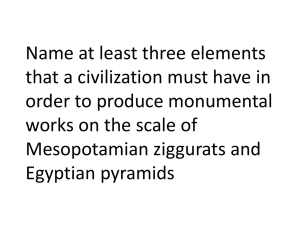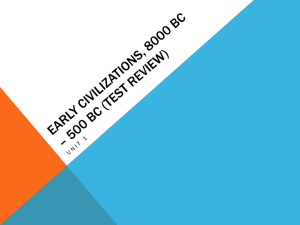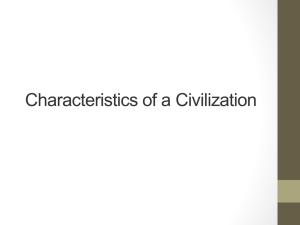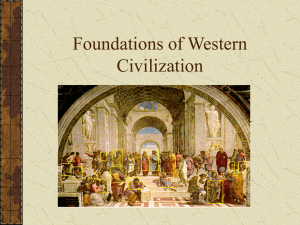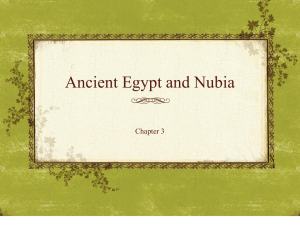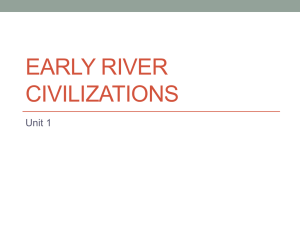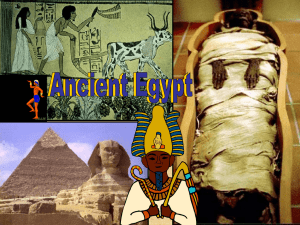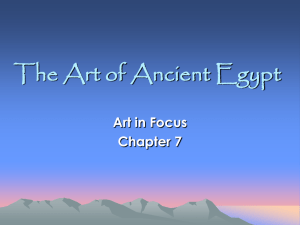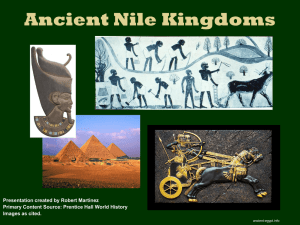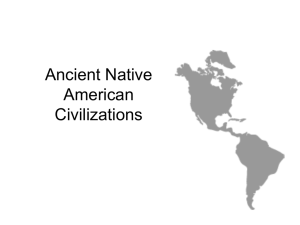Lecture # 4: Ancient Egyptian Civilization
advertisement
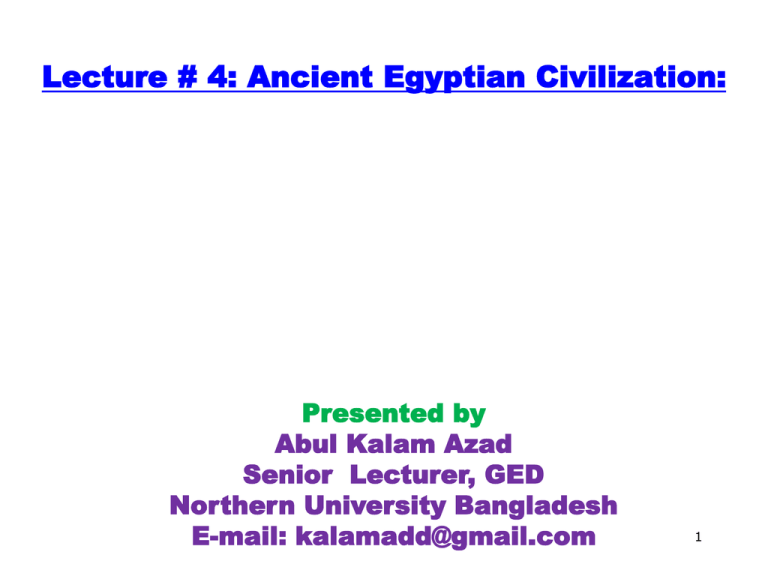
Lecture # 4: Ancient Egyptian Civilization: Presented by Abul Kalam Azad Senior Lecturer, GED Northern University Bangladesh E-mail: kalamadd@gmail.com 1 Egyptian Civilization The basic element in the lengthy history of Egyptian civilization is geography. The Nile River rises from the lakes of central Africa as the White Nile and from the mountains of Ethiopia as the Blue Nile. The White and Blue Nile meet at Khartoum and flow together northward to the Nile delta, where the 4000 mile course of this river spills into the Mediterranean Sea. The flood per year and the deposition of sediment created the land fertile that helped the agricultural production. Its water would be used for the irrigation and flow of water for the navigation. Many achievements of the ancient Egyptians included a system of mathematics, quarrying, surveying and construction techniques that facilitated the building of vast pyramids, temples, glass technology etc. Geographic Condition of Egyptian Civilization The land and the climate of Nile valley were favorable to human progress; The climate was hot but not too hot to thrive life to the animal and the plant; The long season was problematic to plant and harvest two crops a year; The sluggish watercourse encouraged in navigation; The Egyptian took advantages in it and became pioneer in trading in the history; They carried their commodities to the neighboring countries and brought back copper, cobalt, cloth, pottery, metal weapons and many necessary supplies. 5 6 Government System The people of Nile valley turned into imperial organization from a clan. At a local level, the country was divided into 42 administrative regions. The early political period in Egypt can be divided into three ages: 1.The Pyramid Age (3400-2500 B.C.) 2.The Feudal Age (about 1800 B.C.) 3.The Empire (1580-1150 B.C.) Socio- economic Development The people of Egypt became differentiated into three distinguishable classes as followsa) The leisure Class b) The Middle Class c) The Lower Class a) The leisure Class The Pharaoh, VIPs in the empire, priests and the land owners are in the leisure class. The people of leisure class did permit progress in the arts, science and industry. 8 b) The Middle Class The artisan and all the merchants are in the middle class. c) Lower Class The people at the bottom list such as the slaves, serfs, servants etc are in the Lower Class. So a greatest variation was existed in the social classes at that period in the Egypt. 9 Position of the Women ▶The position of women was a unique characteristics of the Egyptian society. Queen ruled the country from time to time. ▶The wife was independent of her own right. ▶The wife of a ruler has the right to transmit the kingship to her children. ▶The position that women held in Egypt was not equal. 10 Agriculture ▶Agriculture was the most important profession of the Egyptian civilization. ▶The actual work was done by the slaves but government officials carefully supervised the work. ▶Government’s engineers and scientists constructed the irrigation project. ▶Ox and the donkey were the main beasts. Sheep and goats were driven over the planted fields in order to march the grain and cover it with soil. ▶The most important crops were the barley, wheat, millet, onions, beans, lettuce and peas. 11 Agriculture 12 Crafts & Architecture ►Though the main profession of the people of Egyptian civilization was agriculture, they involved with other activities Such as Industrial work, construction, Brick making, masonry, metal working and wool carving. ►Ship building became an important trade. They also involved with the work of pottery, jewelry and furniture. ►Their Occupations indicated the diversification of their work and Shows their beauty. 13 Architecture 14 Military Technology: Faience and glass Commerce ▶Commerce did not develop in Egyptian civilization as it was in the Mesopotamian civilization largely because agriculture were more profitable. ▶But there also some trade existed. Goods were carried up and down the Nile. Gold and silver also exchanged there. ▶ Spices, dyes, cosmetics and perfumed woods were brought from Arabia and India. Gold, Ivory and negro slaves were brought from Sudan. ▶As early as 1900 B.C a cannel was constructed through Isthmus of Suez. 17 Arts & Culture ▶The Egyptians were developed in architecture, painting, Sculpture, furniture and the other minor arts. ▶Different temples, pyramids are the symbols of their expert in architecture and sculpture. ▶The use of couches, chairs, shrines (sacred place) and utensils of various kinds were the symbols of their expert in furniture. 18 Culture Religion ▶ Religion dominated the political, economic, social and intellectual life of the Egyptians. ▶They preserved the bodies of the dead with such success known as the Mummies. ▶Some of the Pharaohs have been identified from their mummies even after thousand years of the construction. 20 Religious beliefs Variety of Religions ▶The religious practices of the Egyptians varied from the most fetishism to a close monotheism. ▶Egyptian worshiped sacred animals, the sun, the moon, The Nile river. At that times, there were general confusions and anarchy of Gods. ▶There were people who believed in monotheism and future life and the power of Pharaohs. 22 Literature The people of Egyptian civilization introduced a new era in writing. Their written system was known as the Hieroglyphic. Hieroglyphic was not so popular form of writing like today. The word Hieroglyphic means sacred carving or the written system of the priests. However the Egyptians had no universal written system but the combination of ideographic, Syllabic and alphabetic systems. The most important literature work of the Egyptian civilization were “The Book of The Dead”, “Coffin Text” and The Song of Harper” etc. So they have played important role in the literature as well as other sectors. 23 Learning The Egyptians made contribution to culture and learning aside from literature. Learning was prized very highly. A teacher’s instruction to his pupil was: “ give thy heart to learning and love her like a mother, for there is nothing precious as learning”. The Egyptians studied medical science, Chemistry Commerce and Politics. The Egyptians had a government-supervised educational system from which they were taught politics and commerce. After the completion of graduate from the temple school they sent to the government officials to get the practical knowledge. There was one of the earliest school system in the history of civilization. Writing & Literature 25 Reasons for Decline The reasons for the decline of Egyptian civilization were as follows: The lack of making perfect workable political system and the large variation among the social groups; Imperial administration was the contributing factor; Then the Assyrians, the Macedonians, and the Romans ruled Egypt; Political independence of Egypt destroyed her civilization. Finally we can say that the Egyptian civilization was the milestone and the source of encouragement of all the civilization in the history. 26

